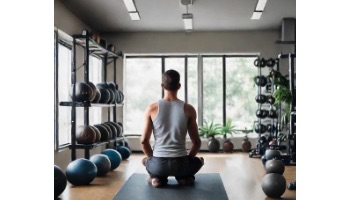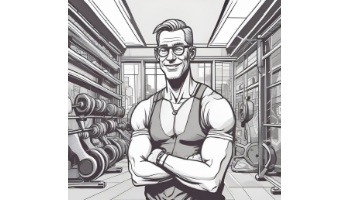 Abs are always worth taking another look at. Everybody wants ripped ones. At the same time, everyone has also heard about the importance of a strong core. Is that the same thing? Plus, how do we get there?
Abs are always worth taking another look at. Everybody wants ripped ones. At the same time, everyone has also heard about the importance of a strong core. Is that the same thing? Plus, how do we get there?
Let’s start with the easy part of this discussion. If you want to have ripped abs you have two options. You can drop your body fat percentage down far enough that they will show through your skin, or you can have the genetics that cause your body to store its extra fat somewhere other than your midsection. Either way, the key is making sure that there is no, or very, very little, adipose tissue covering up your rectus abdominis—the six-headed muscle on the front of your stomach that we all know as the ‘six-pack’.
What about training that muscle though? Doesn’t ab work in the gym make it look better? The answer is yes. If you train that muscle directly and enough to cause growth, it will make it stand out more prominently. However, once again, only if it’s not being hidden under body fat. And no, training that muscle is not going to burn body fat away from your mid-section.
Ab Work And Core Strength—Same Thing?
Ok, so ab work won’t give you ripped abs on its own. What about core strength? Does ab work at least make your core stronger? First, let’s just nail down what we think about under the term ‘ab work’. Usually, that phrase makes people think of exercises like crunches or sit-ups, russian twists, lying or hanging leg raises. People think of those exercises because they target the rectus abdominis, our six-pack friend, and the obliques, another popular mid-section muscle you’ve probably heard of. The key point about this kind of exercise is that it works by targeting the specific movements that those muscles can produce. Crunches pull the rib cage down, ‘crunching’ the chest toward the waist, a main action of rectus abdominis. Twisting movements like russian twists or crossover sit-ups rotate the torso, a main action of the obliques.
Targeting the actions of specific muscles around your mid-section will add some strength to those muscles. However—and this is a big however—that kind of strength is not usually what we are really talking about when we talk about core strength. If you are looking to have a stronger core then it’s not about training the ab muscles to make movements, it’s about training them to prevent them.
The Core Of What ‘Core’ Is All About
Alright, if we really want to get to the bottom of this, we need to step back and talk about what we mean when we say core. Some people in the professional fitness world no longer like the word ‘core’. That’s because, like the word abs, it has been used so often and so loosely that it has become vague. For that reason, let’s get clear on what we mean when we say something like ‘strong core’. In a nutshell, your body has two arms, two legs, and a head. Those appendages attach to a central unit—your torso—and for all intents and purposes, it’s easiest to just think of that whole central unit as your core. Further, this central unit has a very important structural beam running through the center, which you know as your spine. That needs to be kept strong and stable, lest you be plagued by all kinds of unpleasant aches and pains, particularly in the lower part.
This is what the muscles that we sometimes sloppily refer to as ‘the core’ are there for. The core is essentially a group of muscles that, collectively, have the ability to keep your spine in place. You’ll want to remember that your spine is three dimensional. It has a front and back, sides, and even a top and bottom. Hence, the core refers to muscles that go all around the spine. The front and back, the sides, and the top and bottom. You need all of these muscles to work together to keep your spine from going snap.
Training The Core
So, if the most important thing is keeping the spine stable, and that involves having strong muscles all around it, how can we train that effectively? Mostly, by putting ourselves in training situations that make the spine want to move, and then not letting it. This is why planks have become the go-to exercise in core training. When you plank, your body wants to sag in the middle where there is the least amount of support against gravity. It’s basically like one of those rickety suspension footbridges over a river of crocodiles. Your rectus abdominis has the ability to fight back against that sagging, so as you plank, it gets trained and becomes stronger.
Planks are all well and good, but remember that the spine is three dimensional. We need to train it three dimensionally. This is why, contrary to popular fitness vocabulary, exercises like squats and deadlifts are actually even better core work than something like a plank. A squat takes your body through various angles as you go from standing up straight, to squatting down, to standing back up. Deadlifts create even more extreme angles. All the while, it is your core that has to keep your spine from bending like a fishing rod or from getting squashed from pressure. That’s good training for ‘the core’ because it demands that all those muscles work in concert in a dynamic situation, which is what most of life is like. Moreover, you can load these movements heavy. This really ups the level of stress on the muscles and forces them to get much stronger than they would just from resisting gravity alone.
The Summary
To sum up, having pretty looking abs is all about how much body fat you have. Doing exercises that are traditionally labeled ‘ab work’ can make those muscles more prominent, and a little bit stronger, but you’ll still need low body fat to see them. A strong core is about more than the six-pack on the front of your body. It’s about all the muscles around the spine, which need to be strong and work together in order to perform their most important function, which is keeping that spine from moving when it shouldn’t. If you want to train that, you need to move dynamically so that they have to respond dynamically and, if you can load them up, that’s even better. That makes exercises like squats and deadlifts, yes, great ‘ab work’.


